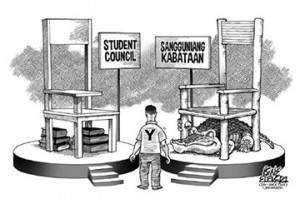An alternative to youth councils

The polls were postponed to give lawmakers time to think of ways to reform the youth councils that have become notorious breeding grounds for corrupt government leaders.
Even as the Senate and the Lower House sought to reconcile their versions of the bill, some solons called for the abolition of the youth councils.
Erasing the councils would marginalize the young, who constitute the bulk of our country’s populace, but only if they are not given an alternative avenue for participating in governance.
We believe a viable alternative exists apart from the spaces for the young that already exist in the government, which bear pointing out.
Assuming that the SK is dissolved, the youth will continue to be represented by party-list groups like Kabataan who will vie to represent them in Congress.
Article continues after this advertisementIn the executive branch of government, the National Youth Commission, currently chaired by Leon Flores and recently given a clean bill of health by the Commission on Audit will continue to pursue the interests of the young.
Article continues after this advertisementThe law allocating 10 percent of each barangay’s budget to programs that directly benefit the youth will still be in effect.
Provincial, city and town councils will not remove committees for the welfare of the children and youth.
Congress must not only consider reforming the SK but open itself to the idea of abolishing the youth councils.
Apart from the existing structures that serve the young minus the SK, our leaders can work to strengthen school-based student councils.
The idea is to make sure all young people are in school, where they can serve the country instead of splitting their time between the curriculum and an extracurricular SK.
The idea has the added advantage of placing young leaders under the mentorship of teachers rather than under the apprenticeship of crooked senior politicos.
A government that is interested in public-private partnerships must not run out of energy to flesh out the mechanics of this alternative especially in relation to the participation of private schools.
It is a good path and the best way to serve young people. We make sure they are educated and insulate their involvement in government from a discredited old guard.